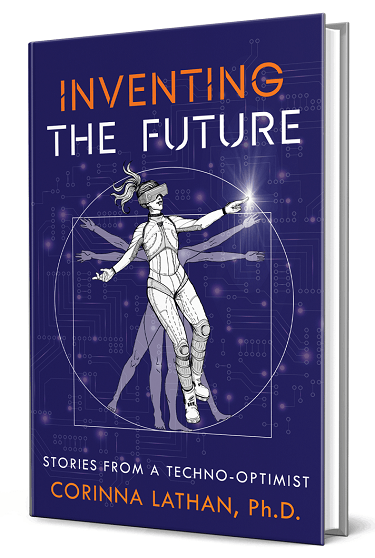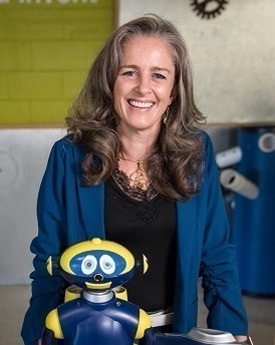Technology as a bridge in time: Shaping the future of brain health via today’s innovations–including those that “fail”
 Remember Google Glass? Google invested millions of dollars and came to market in 2014 with the first generation of wearable augmented reality (AR) technology. You could wear their cool headsets with or without glasses and use them to read and send email all while going about other tasks.
Remember Google Glass? Google invested millions of dollars and came to market in 2014 with the first generation of wearable augmented reality (AR) technology. You could wear their cool headsets with or without glasses and use them to read and send email all while going about other tasks.
Even before it was available to the public, Glass created a huge amount of buzz. In 2013, everyone wanted to get in on beta testing.
Almost every keynote speaker I saw that year would come out wearing a Google Glass headset—and then invariably admit the battery had run out weeks ago and they were just wearing it to look cool. I have to admit, I did the same.
Maybe that’s because it made me nostalgic for a product we had designed about ten years earlier, in 2005. Our Visually Integrated Sensor Unit, or VISUnit, was an early version of an AR headset.
Everyone agrees that Google Glass failed when it came to market, but to me, it’s a symbol of hope. Just the fact that it got to market makes me even prouder of VISUnit, even though our journey was quite a bit different. Glass may have inspired the next generation of AR developers commercially, but our work was likely the first to demonstrate the feasibility of augmented vision systems in the military.
I’ve talked about how technology should enable human capability. It should take us from what we can do to what we want to do. In an ideal world, technology bridges capabilities.
Technology is also a bridge in time.
An invention doesn’t always receive recognition or gain an immediate user base. But it captures and documents a moment that gives rise to the next generation of creators.
The world of technology doesn’t always think this way. People argue over who invented something first. Patents are a way to put a stake in the ground, but that’s all they are. Just because you patent something doesn’t mean it will be a viable product. Although timing is probably one of the most critical factors in the success of technology, it is impossible to predict or control.
What’s interesting with Google Glass is that they probably suspected the timing was wrong, but they tried anyway.
Bringing a tech product to market successfully requires a sweet spot in the Venn diagram overlap of customer need, technology maturity, and market readiness.
If you think of the inventions discussed in previous chapters, you can see why market success is almost always a long shot. In the case of CosmoBot, despite the high need for innovative, interactive educational technologies for kids with disabilities, the technology was not mature. Consumers were not ready to pay the price. So we switched gears and developed Cosmo’s Learning System to hit the sweet spot of need, tech maturity, and market.
But that Venn diagram, pictured at the chapter beginning, is not static. It’s constantly changing. In the case of CLS, the technology and therefore the market changed even though the need did not. As the iPad and other tablet computers became the norm, the tablets drove and changed the need—even though their use was not initially backed by science.
The AcceleGlove flaunted a similar model to Google Glass. We put innovative technology out into the world with some demos and a developer’s kit and let the market create the need. As with Google Glass, the product didn’t make it very far. But both became catalysts for change, albeit on different scales. The AcceleGlove bridged our ideas for gestural interfaces to applications developed by those who purchased the kit or saw a demo. Google Glass gave hundreds of innovators a chance to experience the potential of augmented reality.
Both inventions set the stage for killer apps and compelling use cases. In the case of gestural interfaces, Nintendo and Microsoft later made gestural interfaces the norm for video gaming, with Wii and Kinect. Just as Oculus and Hololens are now making similar inroads for VR/AR. And technology does come back around. Microsoft recently won a $22 billion contract from the military to develop the Integrated Visual Augmentation System, which is an AR system for soldiers’ decision making.
Sounds familiar?
On the consumer side, the fact that Google Glass existed was enough. It inspired people to think beyond traditional ways of moving about our environment. Instead of looking down at a device, we could look out at the world and have an overlay of digital information. It was one of the first steps in physical–digital convergence that we are seeing today throughout many industries. And as someone who has created many inventions that never left the lab or were too early for the market, I love the fact that Glass came out at all!
Facebook, Ray-Ban, and Snap have released smart glasses, which contain embedded cameras. The companies are betting that focusing on the form factor of cool shades and the convenience of being able to take a photo quickly and easily, while not cutting edge, may in fact be the killer app that finally breaks the consumer market open.
Time will tell.
 – Dr. Corinna (Cori) Lathan is a technology entrepreneur who has developed robots for kids with disabilities, virtual reality technology for the space station, and wearable sensors for training surgeons and soldiers. Above is an adapted excerpt from her new book, Inventing the Future: Stories from a Techno-Optimist (Lioncrest Publishing; 2022), which explores the many possibilities of tomorrow through Cori’s twenty-year journey inventing at the edge of technology and human performance.
– Dr. Corinna (Cori) Lathan is a technology entrepreneur who has developed robots for kids with disabilities, virtual reality technology for the space station, and wearable sensors for training surgeons and soldiers. Above is an adapted excerpt from her new book, Inventing the Future: Stories from a Techno-Optimist (Lioncrest Publishing; 2022), which explores the many possibilities of tomorrow through Cori’s twenty-year journey inventing at the edge of technology and human performance.


